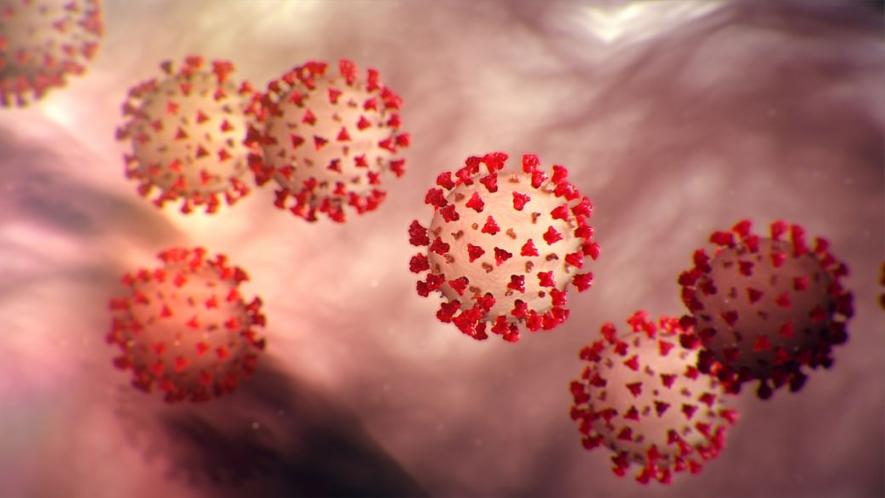Novel Coronavirus Predominantly Airborne, Says Lancet Report, Provides Scientific Evidence

Representational Image. Image Courtesy: National Herald
In what could be one of the most significant findings during the COVID-19 pandemic, researchers have found that SARS-CoV-2, or the novel coronavirus, predominantly spreads via airborne transmission, a report in the peer-reviewed medical journal Lancet has said.
The Lancet report cited ten “streams of evidence” that collectively support the researchers' contention that the virus primarily spreads through air.
The earlier assumption was that the novel coronavirus spreads through droplets that come about when an infected person sneezes, coughs or talks, and that the droplets were bigger in size and readily settle on surfaces. However, if an infectious virus is airborne, then it can spread via aerosols.
Aerosol particles are much smaller, can stay afloat in the air for longer periods and can travel over greater distances in comparison to droplets. This would make containing the virus difficult since an infected person could release aerosols containing the viral particles, even while talking. These aerosol particles could end up reaching someone who inhales them even from a distance. The Lancet report argues that an understanding of whether a virus spreads through droplets or aerosols could have an impact on safety measures as well.
The Ten Streams of Evidence Cited:
1. “Super spreading events account for substantial SARS-CoV-2 transmission; indeed, such events may be the pandemic's primary drivers,” the report said. The researchers analysed human behaviour, interactions, room sizes and ventilation in places where super spreading events could take place, like choir concerts, cruise ships, care homes, slaughterhouses etc. These studies have shown patterns—long range transmission, overdispersion (greater variability in a dataset) of the basic reproduction number R0. (The basic reproduction number of an infection is the number of infections generated from a single case when all individuals concerned are supposedly susceptible to being infected.) These cannot be adequately explained by droplets or fomites (Materials that can carry infection like clothes, utensils or other surfaces). These super-spreading events strongly suggest an airborne transmission of the virus.
2. Reports also suggest long range transmission of the coronavirus between people in adjacent hotel rooms, who never have come met.
3. “Asymptomatic or pre symptomatic transmission of SARS-CoV-2 from people who are not coughing or sneezing is likely to account for at least a third, and perhaps up to 59%, of all transmission globally and is a key way SARS-CoV-2 has spread around the world, supportive of a predominantly airborne mode of transmission,” the report mentions. The mere act of speaking could produce thousands of aerosol particles along with a few large droplets.
4. Transmission of the novel coronavirus is found to be higher indoors than outdoors. Again, this process is substantially reduced by indoor ventilation. It is suggestive of the fact that the virus primarily takes the airborne route to spread further.
5. There are reports of nosocomial infections (infections originating in hospitals or health care facilities) in health care set-ups with strict contact and droplet precautions along with the use of PPE kits against droplets, but not aerosols.
6. In laboratory experiments the coronavirus has been found to remain infectious for up to three hours with a half life of 1.1 hours. Viable viral particles were obtained from air samples of rooms occupied by COVID-19 patients and from inside the car of an infected person.
7. The coronavirus has also been found in air filters and building ducts present in hospitals where COVID-19 patients were admitted. These are locations only aerosols could access.
8. The transmission of the virus has also been found in studies where infected caged animals were connected separately caged uninfected animals through an air duct. This phenomenon can again be adequately explained only by aerosols.
9. “No study to our knowledge has provided strong or consistent evidence to refute the hypothesis of airborne SARS-CoV-2 transmission,” the report mentioned.
10. The researchers say that there is limited evidence to support other dominant routes through which the virus could transmit further. “Ease of infection between people in close proximity to each other has been cited as proof of respiratory droplet transmission of SARS-CoV-2. However, close-proximity transmission in most cases along with distant infection for a few when sharing air is more likely to be explained by dilution of exhaled aerosols with distance from an infected person,” they wrote.
The authors of the report emphasise that airborne transmission of the novel coronavirus should be accepted based upon scientific evidence and that the public health community should strategise accordingly and act immediately.
Get the latest reports & analysis with people's perspective on Protests, movements & deep analytical videos, discussions of the current affairs in your Telegram app. Subscribe to NewsClick's Telegram channel & get Real-Time updates on stories, as they get published on our website.
























